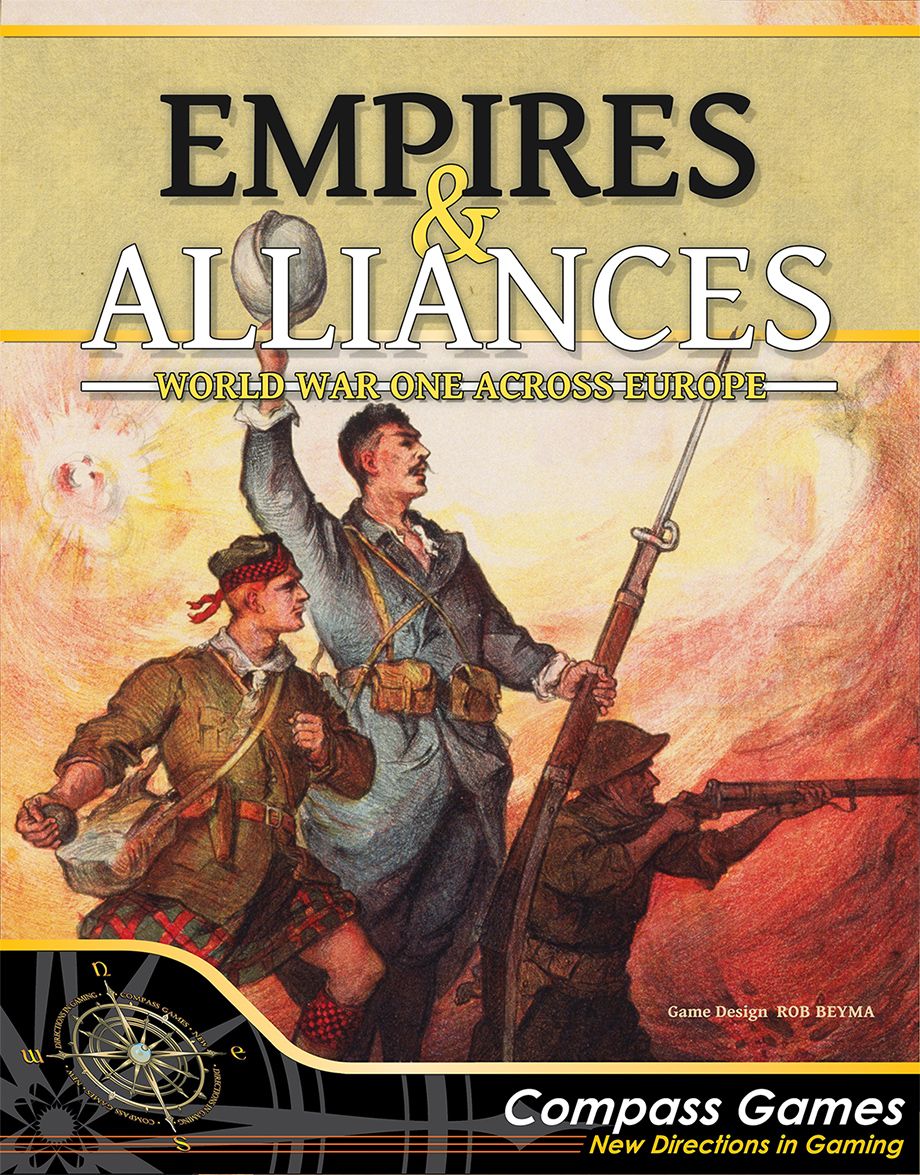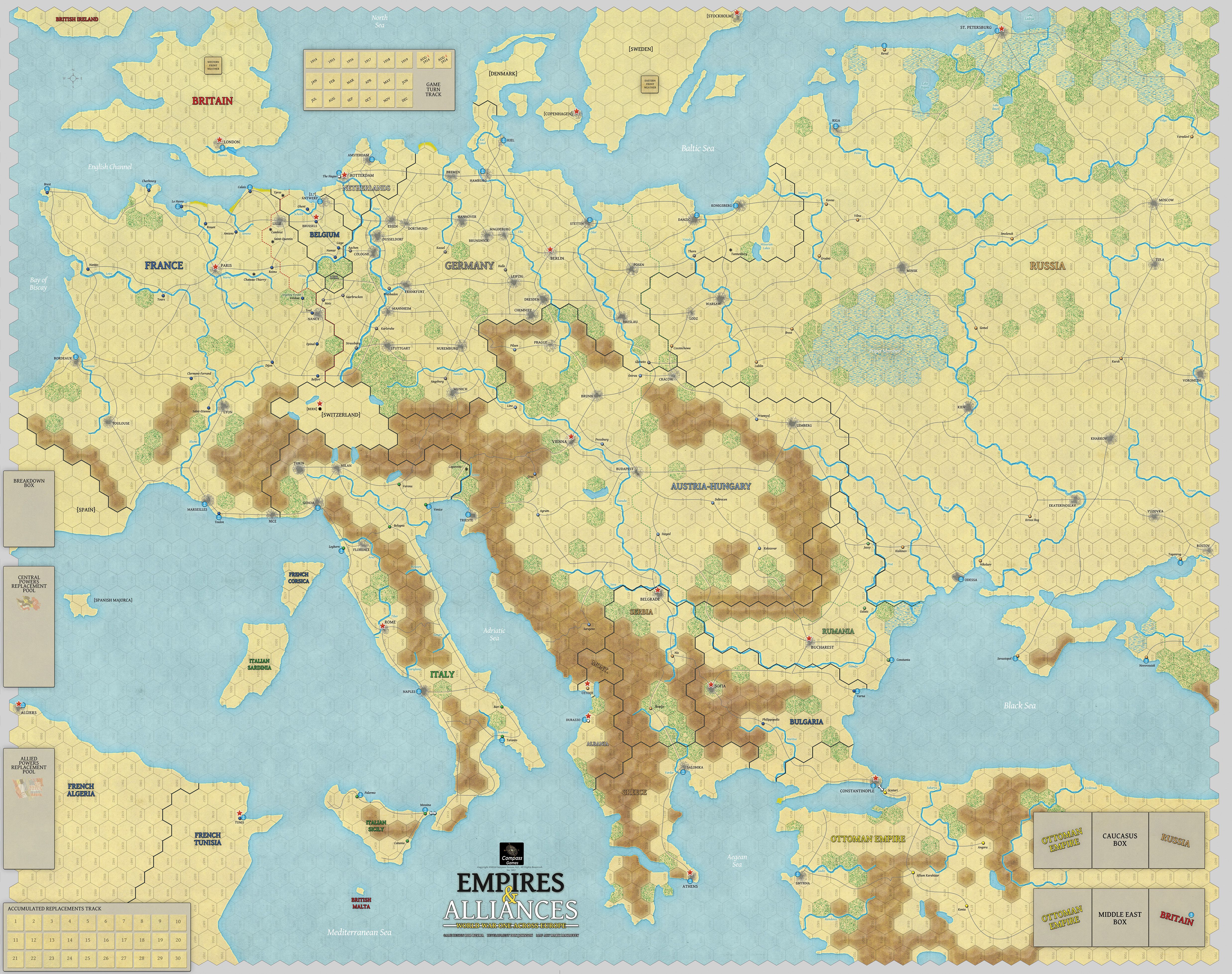The First Game: Empires and Alliances
I will at some point say more about myself and my history in this hobby, but just to give some sort of context I will say that while I have been involved in the hobby (mostly solo) for a long time, and never completely withdrew from it, in the past couple of years I discovered the modern renaissance of boardgaming, which led me to the modern renaissance of historical (board) wargaming. I have been gathering my old games and expanding my collection for a while, and while I've known about Vassal for a while I finally got tired of thinking to myself that I'd get around to figuring it out later, sat down and actually made it happen.
I've chosen as my first Vassal game Empires & Alliances by Compass Games. Here's what you need to know about the game:
I've chosen as my first Vassal game Empires & Alliances by Compass Games. Here's what you need to know about the game:
- Era: World War I
- Location: All of Europe and part of Asia Minor; Caucasus front and Middle East handled abstractly.
- Focus: The land war
- Units: Mostly corps, a few divisions
- Scale: Approximately 30 miles per hex, 1 month per turn
- Designer: Rob Beyna
- How much game is there? 3 full-size and one smaller (1/3 size) mapsheets; 4 counter sheets containing (by my count) 643 unit counters and 257 markers.
Compass has been doing a nice job with game production; the components are high quality; the counters are good-sized, clean and easy to read.
Rob Beyna (along with Frank Davis) is credited as the designer for Avalon Hill's The Guns of August, and this game is intended to be a reimplementation of that 1981 classic. I did own, and actually play a bit of, that original game, though I don't remember it very well. I did take a quick refresher look at it to see where and how it differs. Reimplementation is exactly the correct term for Empires & Alliances. It is very much the child of The Guns of August, and yet it's own entity. TGOA has 4 long mounted mapboards that together (I believe) total the same area of a single E&A mapsheet. You may like the mounted boards, but I remember being annoyed at how easy it was to jostle the different segments. And visually, let's just say E&A is a very nice upgrade.
E&A gives you much more playing area, then. I can't tell you precisely how much because the TGOA map seems a bit tortured, tilted, and squeezed to fit everything they needed in. The E&A map gives you roughly 6 more hexes to the western edge, thereby giving you all of France (TGOA has the western edge running roughly from the west coast of the Cherbourg peninsula to the Franco-Spanish border on the Mediterranean). On the NW side of the map it seems to extend about 2 hexes further than TGOA's map, but on the Eastern side more like 6 (TGOA goes only 1 hex further north than Riga--ie no St. Petersburg). TGOA does just barely manage to squeeze Moscow in on the Eastern edge of the mapboard, but then that edge runs a bit West as you go South, such that by the time you hit the Black Sea coast you are only one hex East of Odessa. E&A gets you 3 hexes East of Moscow and Tula, and even managing to get Voronezh and Rostov in its eastern-most hexrow. The Southeast corner of the TGOA mapboards just barely cover all of European Turkey (and I do mean just barely), then just enough of Greece to give you the Salonika encampment. E&A extends so far East and south that all of Italy, Greece, and the majority of Asia Minor are presented (roughly 10 more hexrows), but not the Caucasus front.
TGOA does provide some things that are not in E&A: There is a (much) more detailed naval game option, more scenarios, and an optional unit production system. TGOA has railroad and fortress engineer units. I also noticed (again this was a very quick perusal) some minor differences in the railroad movement rules. TGOA also gives you many more scenarios: 10 vs 3 for E&A.
I guess I'd say (and again this is not a deep assessment but based on a very quick look) that E&A is more focused on streamlining/abstracting the war to its essentials. My first game will definitely be mostly RAW (Rules As Written) but I could see being tempted to bring in the Naval element and production system from TGOA in a future game of E&A.*
Speaking of Rules, I have been of the mind lately that I hate factor-hunting. I don't want to deal with being 1 or 2 points from the next ratio, so I am going to probably play most of my games with a variable CRT ratio. What that means is, I will count up the attacking factors, and divide them by the defending factors as normal, but I will round down to the nearest tenth. Then I will roll a d10, and if I roll the tenth digit or lower I will move up to the next ratio. For example, 26 attack factors against 12 defense factors gives us 26/12, or 2.16666.... I round that down to 2.1, then roll a d10, and if I get a "1" or lower (not possible in this case as 0s are read as 10s). then I roll on the 3:1 table; if not i roll on the 2:1 table. Note I do not get to cancel the attack if I don't like the result.
As much as I like the idea of this system, there is one feature of the E&A RAW that did give me pause and consider whether I should do this or not. The E&A rules allow you to break up an attack into a hex, allowing you to focus higher odds on a single unit. You do, however, still have to attack every unit in the hex. After some consideration, I decided I would still go with my variable CRT, though I might not use it for divided attacks.
* Ha ha ha, who am I kidding? Return to this game? Sure, right after I play Balance of Powers, Storm of Steel, World War I, Fatal Alliances, Der Weltkreig series, March to Victory / Over There, La Grande Guerre 14-18, The Great War in Europe Deluxe, Paths / Illusions / Pursuit of Glory, The Lamps Are Going Out, The 1914 series, The Great War in the East, Plan 1919, Teutons!, and the War in Europe module The First World War. And that's just the WWI games. Whew!






Comments
Post a Comment